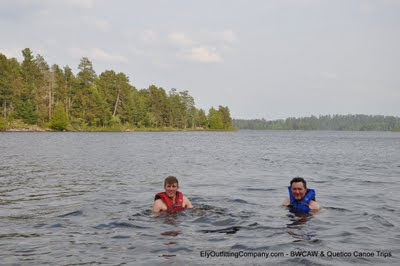

We planned a significant travel route for the trip - one that would challenge them physically and include travel on a variety of small, medium, and large lakes. The trip launched at the Moose River North (Entry Point 16) landing, and ended six days, and fifty miles, later at the Mudro Lake entry point. One of the highlights of the route is spectacular Curtain Falls (below) on the international border.

June is a glorious time to be in the Boundary Waters. It is a time of much new growth and change. The symbol of change is similar to that of a young man transitioning from life at home to moving away for college.
One of the intriguing things about traveling at this time of year is that you see plants at all stages of development. Gary and Blake enjoyed learning about the various plants of the area. Depending on soil types and locations, we saw many plants at different stages of development. For example, we passed many Clintonia plants (below). We saw them just poking through the ground, at a stage of larger leaves, and also with their yellowish-green flowers. Later this summer the flower will be replaced by a blue berry.


Although the berry is not edible, the young leaves are edible and taste a lot like cucumber. Blake is a fan of the Survivor Man television show and enjoyed learning about edible wilderness plants, and eating them.

Another one of the interesting plants we saw at various stages of growth is the sarsaparilla plant. This is the "not poison ivy" plant. It is often confused with poison ivy because it has three leaves at the end of its stems. When it is young, the leaves have a reddish hue, and then they become green, and grow interesting spheres of flowers (below).




And the ferns ranged from the stage of youthful, unfurling fiddleheads to showing as fully opened.


We also saw a variety of spectacular wildflowers, including these bunchberry plants, now showing their white flowers....

...and these pink ladyslippers...


...and this columbine.

The trip involved a significant amount of portaging, and the related time for looking at the plants along the trail. But, we also spent a significant amount of time ramping up North Woods fishing skills, and wetting lines. Gary didn't catch a fish on the 1970 trip, and we were determined to improve on that this time around. We did. Blake pulled in this 18.5" lunker smallmouth bass on Iron Lake with a number 8 Rapala Shad Rap in perch color, and a trophy 27.5" walleye on Crooked Lake trolling another Rapala.


These deeper, larger lakes still held cold water temps of only about 54-55 degrees. The shallow bays and smaller lakes held warmer temps up to about 64 degrees. On the larger lakes, the smallmouth were deeper and not close to shore on their beds. The cold temps made for refreshing swims. Here are Gary and Blake at the north end of Friday Bay on Crooked Lake. The swim didn't last long.

In addition to the fish, we met some interesting critters. For example, we watched a muskrat swim under our canoe, and Blake went toe to toe with a grouse on a portage trail. Blake first thought the bird was going to attack him. She was in defender mode - defending her nest of eggs laid only a few feet off the portage trail between Bullet and Moosecamp Lakes.



We also paddled past this Canada Goose laying on her eggs atop an old beaver lodge.

A trip in the Boundary Waters is a special thing for parents to share with their children. A father-son experience, such as this one I had the privilege of guiding, can be a powerful and life-changing event. It can develop confidence and trust in one another, and provide a platform for continued sharing. It is certainly a life event that will be relived and retold at family events over the years to come.

2 comments:
These pictures make me so excited to be up there in July!
Excellent account of a great trip, thanks for sharing.
Post a Comment